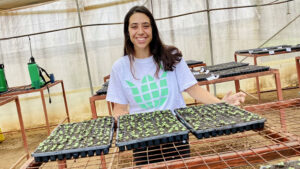Several trends become quickly apparent when we engage the public about agriculture. Consumers across the industrialized world reject concepts like “factory” and “technology.” There is a perception that says big is bad and the tiny, quaint food production methods of yesteryear can easily provide adequate sustenance for a growing planet.
“The reality is that we’ll need to produce more food with fewer resources, on less land, using less water. It is a challenge that will only be met with smart and sustainable intensification and more ag innovation.”
We all want a clean environment, the highest quality safe food for our families, profitable livelihoods for farmers and food security throughout the planet. We want less food waste, lower carbon footprints and a socially sensitive food system.
But the barriers to these important goals grow every day. With every passing minute, the area of arable cropping land acquiesces to population growth. Water resources recede, unprecedented weather events descend devastation to individual farms and strike crop production from massive growing regions. Our conduits of transport stowaway pests and pathogens that spread with hurried speed. Farm labour is increasingly scarce. Old-school crop protection chemistries have been phased out and many new approaches slowly drip toward obsolescence.
In short, to attain our goals of profitable production, ensuring food security and sustainability, we will need to dial it up, not dial it back. Innovation will be the cornerstone of Green Revolution 2.0.
Genome Guided Selection – allows plant breeders to connect a specific DNA signature to a specific trait. This means that a scientist can examine the DNA of a seedling and make accurate predictions about the fruit it will produce years down the line. Until very recently, fruit crop breeders made crosses and waited years to test the fruit, occupying substantial acreage and costing a fortune in labour, fertilizer, water, and other resources. Today they can test thousands of seedlings at one time and predict the few that are most likely to make superior fruit, survive a drought or endure intense disease—overnight.
Big Data and Smart Farming – technology such as on-farm sensor networks will stream data to computer servers, monitoring the environmental state of the farm. Soil moisture, soil temperature, ambient weather, nutrient state and the presence of pests and pathogens will all be carefully analysed. Satellites will assess plant health across the field, drones will collect data on plant health and plant stress and this data will be integrated and analysed to guide decisions and implement solutions through automation.
Gene Editing – has the opportunity to cut farmer costs, decrease insecticide use and benefit farmers’ safety. Gene editing is a more surgical approach to adjusting the genetic blueprint that, in countries accepting of the practice, is leading to rapid variety development, making plants more resilient to stress, more efficient at water and nutrient use, more resistant to pathogens and pests and potentially increasing yields and nutrient content of consumer products.
Robotics – guided by GPS or machine vision, solar-powered robots will walk the fields, destroy weeds, and harvest produce. Drones and rovers will ‘sniff’ the air for signature volatile compounds emitted by specific pathogens, long before they become problematic. Rovers will inventory insect populations and call-in spot treatments with the right solutions. Battery technology will allow mechanized farm labour to work the field twenty-four hours a day.
Local Production in Controlled Environments – indoor farming seeks to grow food where people are—in urban areas. While agronomic commodities like wheat will be unlikely to grow in confined space, artificial environments are perfect for high value crops like herbs, small fruits, and leafy vegetables. Such operations repurpose unused city space, revitalize forgotten neighbourhoods, employ local workers, and supply local markets with fresh produce only hours old with a negative carbon footprint.
Man believes that a retreat to old methods and ancient practices will somehow sustainably feed more people. The reality is that we must apply the technology that has transformed communication, medicine, and commerce to agriculture if we are going to feed a growing planet sustainably.
The future of farming will be driven by innovation. Without acceptance of emerging technologies, the growing world is at risk.
Editor’s Note: Kevin Folta is professor at the University of Florida.












